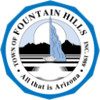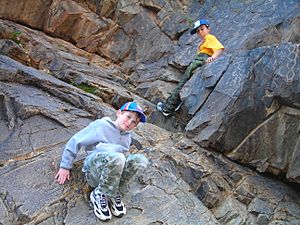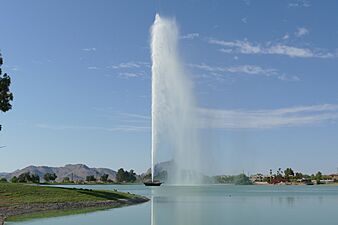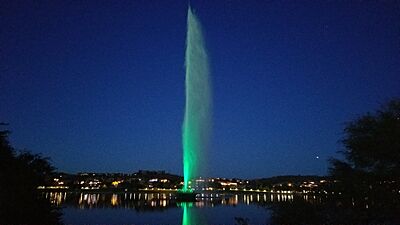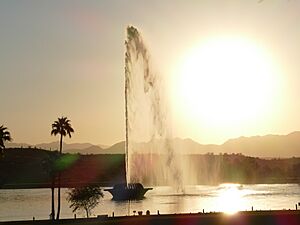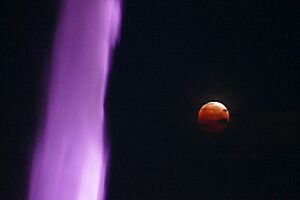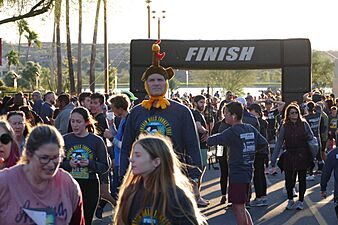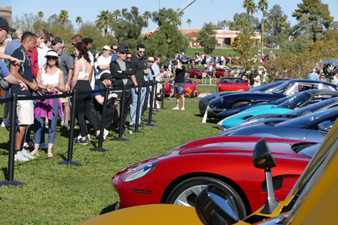Fountain Hills, Arizona facts for kids
Quick facts for kids
Fountain Hills, Arizona
|
|||
|---|---|---|---|
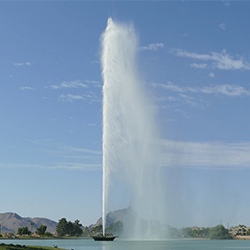
The fountain of Fountain Hills can shoot water to a height of up to 560 feet (170 m).
|
|||
|
|||
| Motto(s):
"All That Is Arizona"
|
|||
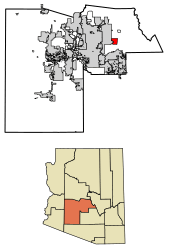
Location of Fountain Hills in Maricopa County, Arizona
|
|||
| Country | |||
| State | |||
| County | |||
| Incorporated | 1989 | ||
| Area | |||
| • Total | 20.37 sq mi (52.76 km2) | ||
| • Land | 20.28 sq mi (52.53 km2) | ||
| • Water | 0.09 sq mi (0.22 km2) | ||
| Elevation | 1,798 ft (548 m) | ||
| Population
(2020)
|
|||
| • Total | 23,820 | ||
| • Density | 1,174.38/sq mi (453.43/km2) | ||
| Time zone | UTC-7 (MST (no DST)) | ||
| ZIP codes |
85268-85269
|
||
| Area code(s) | 480 | ||
| FIPS code | 04-25300 | ||
| GNIS feature ID | 2412647 | ||
Fountain Hills is a town in Maricopa County, Arizona, in the United States. It's famous for its amazing fountain, which was once the tallest in the world! The town is next to the Fort McDowell Yavapai Nation, the Salt River Pima-Maricopa Indian Community, and Scottsdale. In 2020, about 23,820 people lived there. Between 1990 and 2000, Fountain Hills was one of the fastest-growing places in Arizona.
Contents
History of Fountain Hills
Before Fountain Hills was built, the Yavapai people lived in this area. You can still find ancient rock carvings, called petroglyphs, near the Dixie Mine in the town's northwest corner. These carvings tell stories from long ago.
In the early 1900s, the land where Fountain Hills and the McDowell Mountain Regional Park now stand was part of a large farm called the P-Bar Ranch. Today, Fountain Hills High School is built on the spot where one of the ranch buildings used to be. There's even a special plaque in the parking lot to remember this history.
Fountain Hills was created by C. V. Wood, who worked for McCulloch Oil. The town got its name from the huge man-made fountain at its center. Fountain Hills officially became a town in 1989.
Geography and Nature
Fountain Hills is located in eastern Maricopa County, right on the edge of the big city area of Phoenix. It's about 31 miles (50 km) northeast of downtown Phoenix. The town sits on the east side of the McDowell Mountains.
The town covers about 20.4 square miles (52.8 square kilometers) of land. The fountain itself is at an elevation of about 1,520 feet (463 meters), which is 500 feet (152 meters) higher than Phoenix. The land gets even higher on the western side of town, reaching about 3,190 feet (972 meters) in the McDowell Mountains.
To the east of Fountain Hills, you'll find the Verde River, which flows into the Salt River. Inside the town, there are many "washes." These are dry riverbeds that fill with water when it rains a lot. Sometimes, these washes can even block roads during heavy rain! Signs are placed where washes cross major streets to warn drivers.
The McDowell Mountains, to the southwest and northwest, are old volcanoes. The tallest peaks in this mountain range, like East End, McDowell Peak, and Thompson Peak, are in nearby Scottsdale.
Climate
Fountain Hills gets a lot of sunshine all year because of its weather patterns. It has a hot desert climate, which means it's usually warm and dry.
| Climate data for Fountain Hills, Arizona, 1991–2020 normals, extremes 1979–present | |||||||||||||
|---|---|---|---|---|---|---|---|---|---|---|---|---|---|
| Month | Jan | Feb | Mar | Apr | May | Jun | Jul | Aug | Sep | Oct | Nov | Dec | Year |
| Record high °F (°C) | 82 (28) |
91 (33) |
101 (38) |
107 (42) |
114 (46) |
121 (49) |
125 (52) |
118 (48) |
115 (46) |
107 (42) |
95 (35) |
84 (29) |
125 (52) |
| Mean maximum °F (°C) | 75.6 (24.2) |
80.4 (26.9) |
88.6 (31.4) |
97.4 (36.3) |
103.9 (39.9) |
110.9 (43.8) |
112.6 (44.8) |
111.4 (44.1) |
107.7 (42.1) |
100.5 (38.1) |
87.5 (30.8) |
76.5 (24.7) |
114.0 (45.6) |
| Mean daily maximum °F (°C) | 63.9 (17.7) |
67.4 (19.7) |
73.9 (23.3) |
82.0 (27.8) |
91.0 (32.8) |
100.6 (38.1) |
103.0 (39.4) |
101.9 (38.8) |
97.1 (36.2) |
86.6 (30.3) |
73.7 (23.2) |
63.0 (17.2) |
83.7 (28.7) |
| Daily mean °F (°C) | 54.2 (12.3) |
56.8 (13.8) |
62.3 (16.8) |
69.2 (20.7) |
77.8 (25.4) |
86.7 (30.4) |
91.6 (33.1) |
90.9 (32.7) |
85.4 (29.7) |
74.6 (23.7) |
62.5 (16.9) |
53.5 (11.9) |
72.1 (22.3) |
| Mean daily minimum °F (°C) | 44.5 (6.9) |
46.2 (7.9) |
50.7 (10.4) |
56.4 (13.6) |
64.5 (18.1) |
72.8 (22.7) |
80.3 (26.8) |
79.8 (26.6) |
73.7 (23.2) |
62.6 (17.0) |
51.3 (10.7) |
43.9 (6.6) |
60.6 (15.9) |
| Mean minimum °F (°C) | 32.6 (0.3) |
35.0 (1.7) |
39.7 (4.3) |
45.1 (7.3) |
53.1 (11.7) |
62.0 (16.7) |
69.6 (20.9) |
69.9 (21.1) |
62.8 (17.1) |
48.8 (9.3) |
38.9 (3.8) |
31.9 (−0.1) |
29.8 (−1.2) |
| Record low °F (°C) | 23 (−5) |
25 (−4) |
30 (−1) |
36 (2) |
44 (7) |
49 (9) |
57 (14) |
58 (14) |
51 (11) |
37 (3) |
29 (−2) |
24 (−4) |
23 (−5) |
| Average precipitation inches (mm) | 1.41 (36) |
1.33 (34) |
1.28 (33) |
0.33 (8.4) |
0.23 (5.8) |
0.14 (3.6) |
0.80 (20) |
1.33 (34) |
0.81 (21) |
0.63 (16) |
0.74 (19) |
1.15 (29) |
10.18 (259) |
| Average precipitation days | 3.6 | 3.9 | 3.4 | 1.4 | 1.2 | 0.3 | 2.9 | 4.4 | 2.6 | 2.3 | 2.2 | 3.4 | 31.6 |
| Source: NOAA | |||||||||||||
People and Population
| Historical population | |||
|---|---|---|---|
| Census | Pop. | %± | |
| 1980 | 2,771 | — | |
| 1990 | 10,030 | 262.0% | |
| 2000 | 20,235 | 101.7% | |
| 2010 | 22,489 | 11.1% | |
| 2020 | 23,820 | 5.9% | |
| U.S. Decennial Census | |||
In 2020, there were 23,820 people living in Fountain Hills, spread across 11,918 homes. This means there were about 1,114 people per square mile. Most people (94.1%) were White. Other groups included Black or African American (1.0%), Native American (0.6%), and Asian (1.8%). About 4.1% of the population was Hispanic or Latino.
In these homes, 18.6% had children under 18 living there. Most homes (59.4%) were married couples. About 25.7% of homes had someone living alone. The average age of people in Fountain Hills was 53.9 years old. About 14.4% of the population was under 18, and 27.8% were 65 or older.
The average income for a household in Fountain Hills between 2016 and 2020 was $85,200 per year.
Arts and Culture
The Famous Fountain
Fountain Hills is home to the fourth-tallest fountain in the world, and the second tallest in the United States! It was built in 1970 by Robert P. McCulloch. The fountain shoots water into the air for about 15 minutes every hour, from 9 AM to 9 PM.
The water comes from a concrete "water-lily" sculpture in the middle of a large man-made lake. Three powerful pumps, each 600 horsepower, push water at a rate of 7,000 gallons (26,500 liters) per minute through a large 18-inch (46 cm) nozzle. When all three pumps are working perfectly, the fountain can reach an amazing height of 560 feet (171 meters)! Usually, only two pumps are used, making the fountain about 300 feet (91 meters) tall. When it was first built, it was the tallest fountain in the world for over ten years.
You can even watch the fountain live! The town has partnered with EarthCam to provide live streaming views on the Experience Fountain Hills website. For its 50th birthday, the fountain got new LED lights. Now, 10 lights (four under the fountain and six on the shore) can shine in eight different colors, making the fountain look beautiful at night while still following "Dark Skies" rules.
An International Dark Sky Community
In 2018, Fountain Hills was named an International Dark Sky Community by the International Dark Sky Association. This means the town works hard to keep its night sky dark, making it great for stargazing! It's one of only two such communities near a big city.
The town is protected from city lights by the McDowell Mountains to the west. Also, nearby lands like the Fort McDowell Yavapai Nation and the Salt River Pima-Maricopa Indian Community help keep the skies dark. Fountain Hills has very few street lights and uses special outdoor lights that don't cause much light pollution.
The Fountain Hills Dark Sky Association (FHDSA) is even planning to build a large International Dark Sky Discovery Center. It will have an observatory for looking at stars, a planetarium, and other cool exhibits. An astronomer named Charles W. Juels discovered 475 asteroids from his Fountain Hills Observatory between 1999 and 2003!
Events and Festivals
Fountain Hills hosts many fun events each year at Fountain Park. These include two big art fairs: the Spring Fountain Festival of Fine Arts and Crafts and the Fall Fountain Festival of Fine Arts and Crafts.
Every year, on St. Patrick's Day, the town celebrates by dyeing the famous fountain green! This tradition started in 1979. Other popular events include a 4th of July celebration, a Music Fest, an Irish Fest, and Concours in the Hills. Concours in the Hills is a huge car show that brings together over 1,000 amazing cars and attracts thousands of visitors.
Public Art and Theater
Fountain Hills has one of the largest collections of public art in Arizona, with over 150 pieces! This art is a big part of the town's history and look. The eight fountains along the Avenue of the Fountains were the first pieces in this collection. You can see bronze sculptures and other art, from funny to serious, all over the streets, buildings, and parks. The collection includes paintings, stone sculptures, photographs, and metal art. Visitors can walk around and enjoy the art, or even take a guided "Art Walk" tour.
The Fountain Hills Theater is a place where people can watch live performances. It puts on more than 16 shows each year for the community. It also has year-round arts education programs for young people.
Education
Students in Fountain Hills attend schools that are part of the Fountain Hills Unified School District #98. The district offers education from pre-school all the way through high school. The schools include Little Falcons Preschool, McDowell Mountain Elementary, Fountain Hills Middle School, and Fountain Hills High School. The classes are usually small, with about 18 students per teacher. The district also has special education programs, an online learning option called Fountain Hills Virtual Academy, and programs for career and technical education.
Local News
The Fountain Hills Times Independent is the town's weekly newspaper. It prints about 3,000 copies each week. The company that owns the newspaper also publishes other community newspapers in different states and prints telephone directories and community guides for Fountain Hills.
Famous People from Fountain Hills
Some well-known people have lived in Fountain Hills, including:
- Kathy Ahern, a professional golfer
- Steven Alker, a professional golfer
- Charles Juels, an astronomer who discovered many asteroids
- David Schweikert, a U.S. Congressman
Sister Cities
Fountain Hills has "sister cities" in other countries, which means they have special friendly relationships. These cities are:
 Concepcion de Ataco, El Salvador
Concepcion de Ataco, El Salvador Dierdorf (Rhineland-Palatinate, Germany)
Dierdorf (Rhineland-Palatinate, Germany) Zamość, Poland
Zamość, Poland
See also
 In Spanish: Fountain Hills para niños
In Spanish: Fountain Hills para niños



